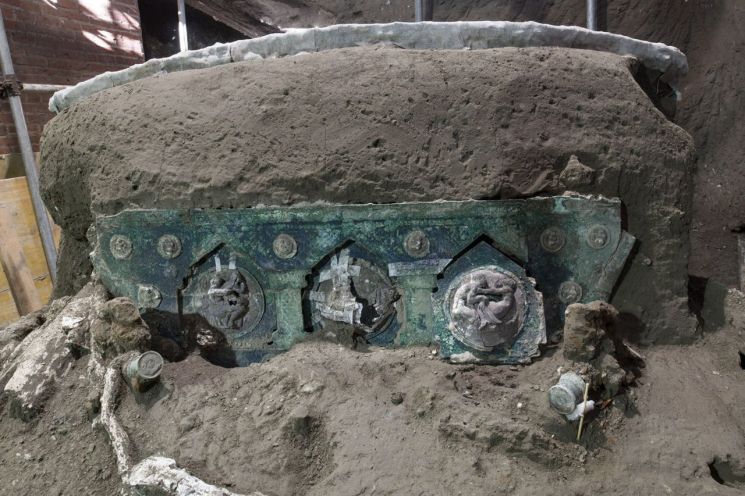
An official from the park who excavated the wagon said that the sculptures and decorations on the side of the wagon were in a relatively good state of preservation, and evaluated it as “a very special excavation.” [이미지출처=EPA연합뉴스]
[아시아경제 최은영 기자] In Pompeii, Italy, a carriage used in ancient Roman times appeared to the world. It is evaluated that it has high archaeological value because the composition, such as decorations and wheels, were excavated in a complete form.
On the 27th (local time), Pompeii Archaeological Park announced through a press release, “The four-wheeled carriage used at events such as weddings and parades was excavated at the ancient villa of Civita Giuliana.”
According to the press release, the wagon excavated this time was found in very good condition, and no wagon has been preserved in such excellent condition to date. The park side was surprised, saying, “Considering the conservation conditions, there was nothing comparable to this in Italy so far.”
The discovered wagon was about 90 cm wide and 140 cm long, and was found with all four wheels on it. The body is made of iron, and there is a child-shaped ornament made of copper and tin on the back. The park assumed that this ornament was Cupid, the god of love in Roman mythology.
In addition, the bronze and tin decoration on the side of the carriage was barely damaged, and the ropes used in the carriage and the marks on the part where the flower was decorated were clear.
![A wagon excavated 2,000 years ago in the Pompeii area. [이미지출처=EPA연합뉴스]](https://i0.wp.com/cphoto.asiae.co.kr/listimglink/1/2021022819153598852_1614507334.jpg?w=560&ssl=1)
A wagon excavated 2,000 years ago in the Pompeii area. [이미지출처=EPA연합뉴스]
The park said, “Up to now, a carriage for transportation has been unearthed, but the carriage used for the event has been unearthed for the first time.” May have been used to move to a new house.”
Meanwhile, Civita Giuliana, where the wagon was found, is a city located north of the ancient city walls of Pompeii in Italy. The remains of three horses and horse harnesses were found in this area at the end of 2018, so it is believed to be a stable of an ancient noble mansion.
Archaeologists have begun excavating artifacts at the villa in 2017. In particular, it is known that the excavation work was hastily determined because the risk of robbing is high, such as several tunnels being excavated underground.
Pompeii, the most prosperous city in the Roman Empire, was instantly destroyed by the Vesuvius eruption in 79 AD. The excavation work began in earnest when the ruins were excavated during the construction of the waterway in the first century. Currently, excavation work has progressed enough to give a glimpse of the form of the city in the past. In 1997, it was registered as a UNESCO World Heritage Site in recognition of its archaeological value.
Intern reporter Choi Eun-young [email protected]
